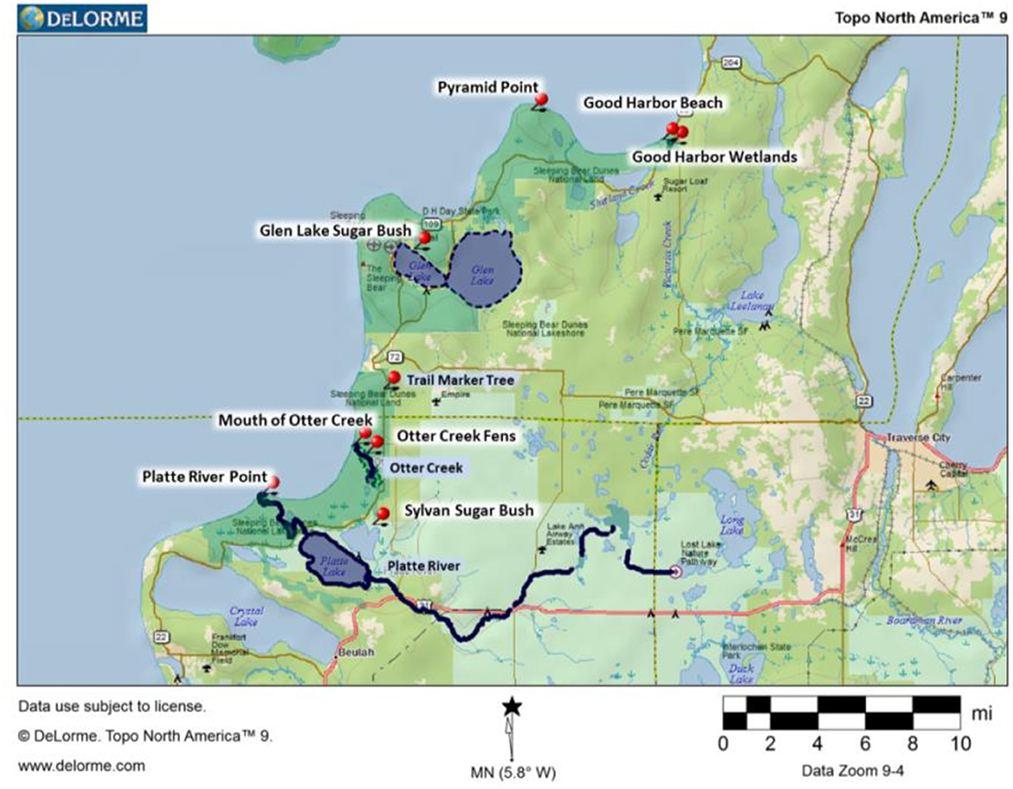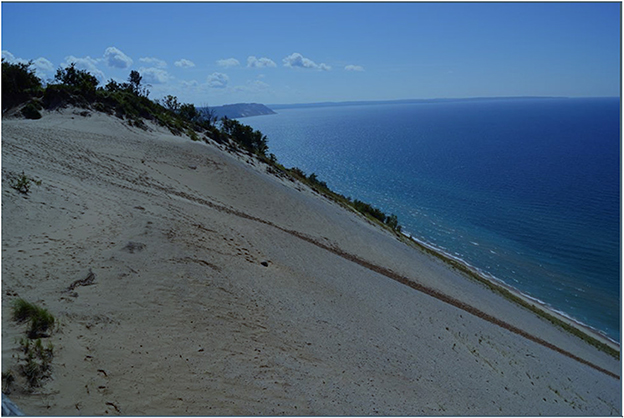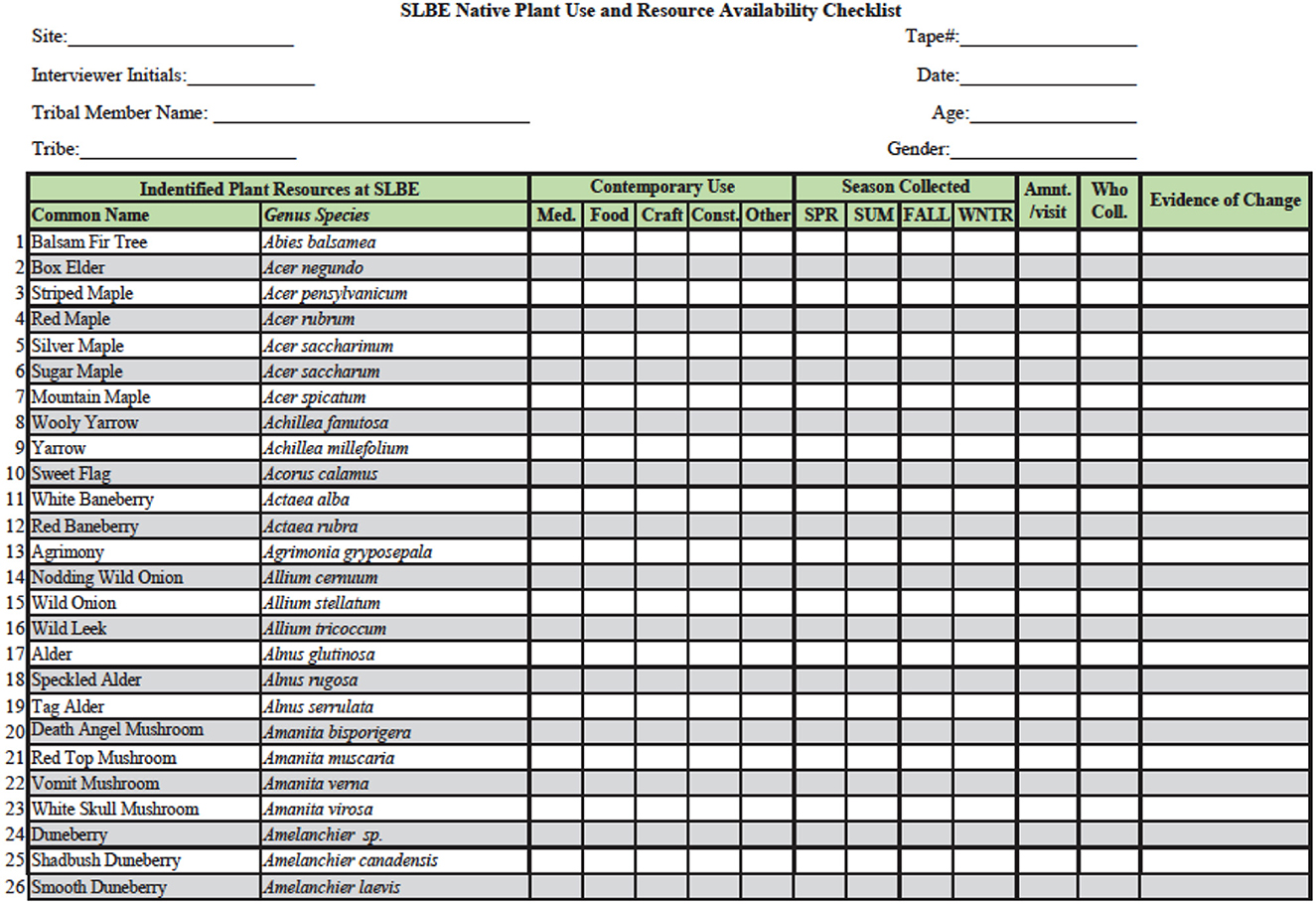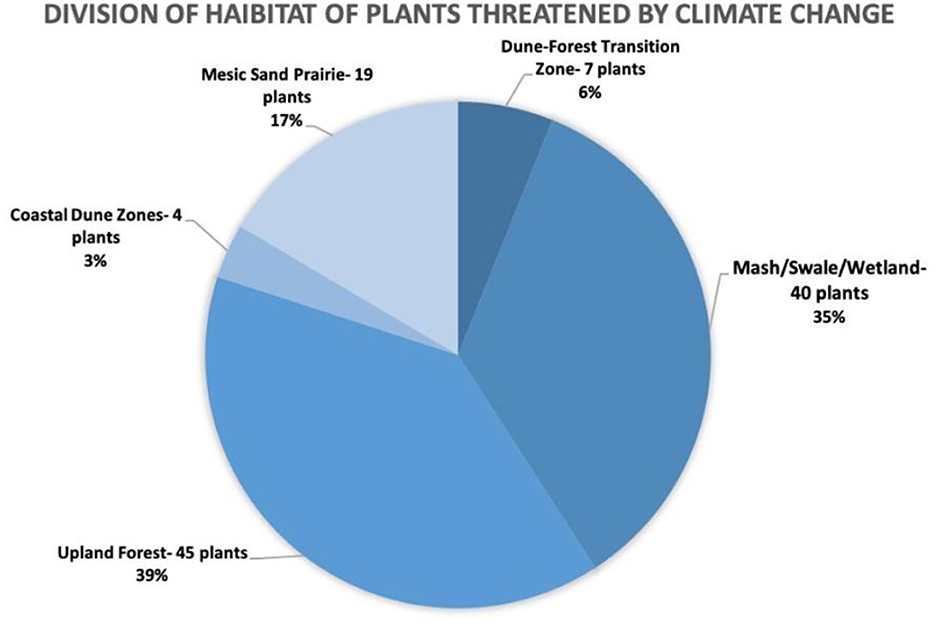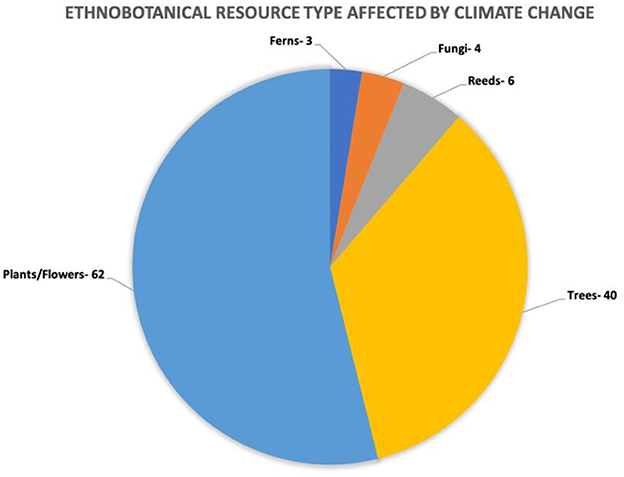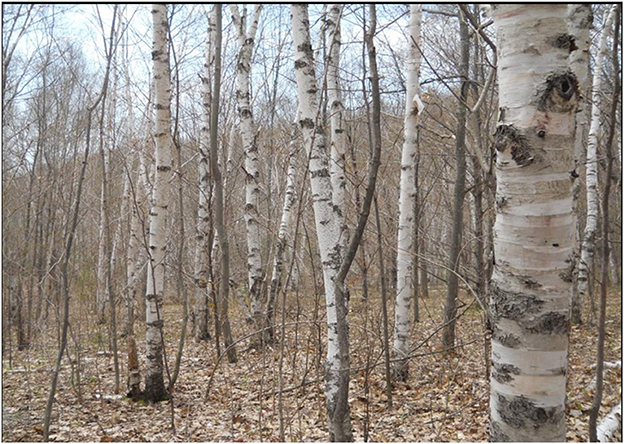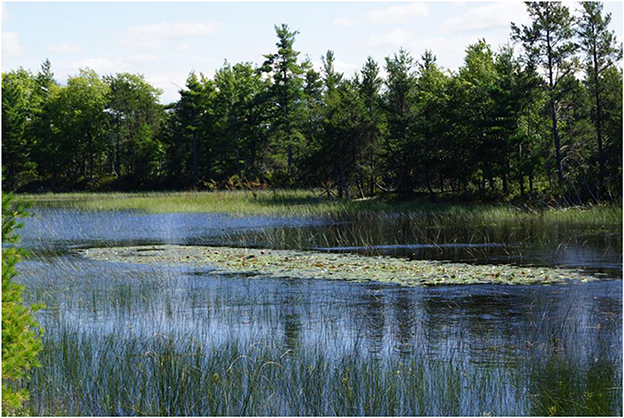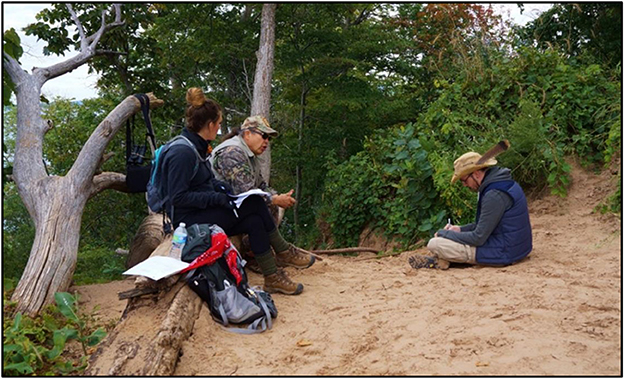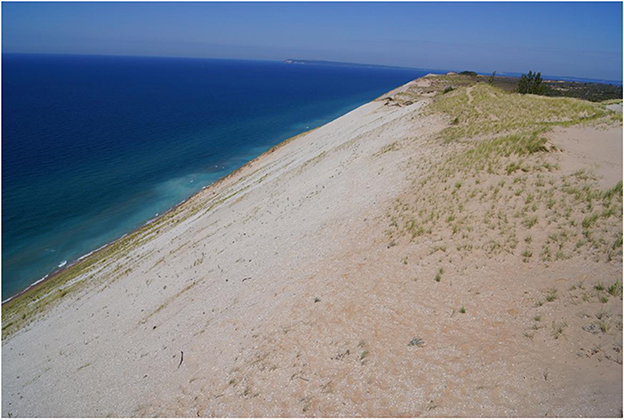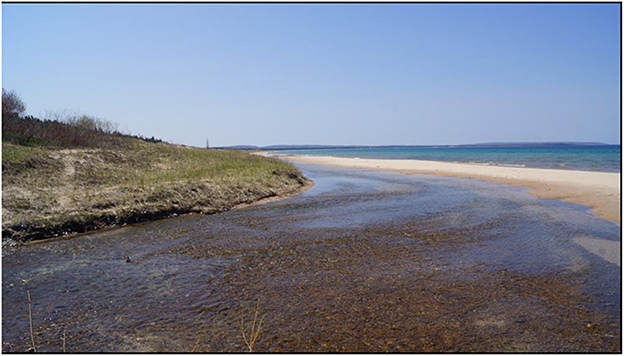- 1School of Anthropology, University of Arizona, Tucson, AZ, United States
- 2National Park Service, Midwest Region, Omaha, NE, United States
- 3Grand Traverse Band of Ottawa and Chippewa Indians, Peshawbestown, MI, United States
- 4Living Heritage Research Council, Cortez, CO, United States
Climate change has been observed for hundreds of years by the plant specialists of three Odawa Tribes in the Upper Great Lakes along Lake Michigan. Sleeping Bear Dunes National Lakeshore (SLBE) is the focus of two National Park Service (NPS) studies of Odawa Traditional Ecological Knowledge (TEK) of plants, ecosystems, and climate change. Data collected during these studies contributed to developing Plant Gathering Agreements between tribes and parks. This analysis derived from 95 ethnographic interviews conducted by University of Arizona (UofA) anthropologists in partnership with expert elders appointed by tribes. Odawa elders recognized in the park 288 plants and five habitats of traditional and contemporary concern. Tribal elders explained that 115 of these traditional plants and all five habitats are known from multigenerational eyewitness accounts to have been impacted by climate change. The TEK study thus represents what Odawa people know about the traditional environment and thus provides a foundation for more complex government-to government relationships between Odawa tribes and the NPS. These research findings are neither intended to test Native TEK nor the climate findings of Western science. It should however be pointed out that both are in general agreement about what has happened due to climate change and thus there is now a TEK data base for co-stewardship.
1. Introduction
Climate change is a global issue. The United Nations passed a resolution fifty years ago specifying the steps needed to recognize and address threats to the global population and the planet. Since then, many additional U.N. recommendations have been issued, including the Paris Agreement for climate change, and the UNESCO agreement on heritage conservation, and the 2023 COP agreements. This essay contributes to ongoing discussions occurring worldwide as part of the United Nations Agenda for 2030, which calls for new Goals for Sustainable Development (GSD) to protect the planet by promoting sustainability in food production and consumption and mitigating climate change by informing both policies and practice.
Traditional people who are at the center of this analysis have developed over hundreds of years complex understandings about and adaptations to many aspects of their homeland biogeography (Whittaker, 1998). Anthropologists understand cultures by analyzing specific adaptations that are functionally clustered in what is called trait or activity complexes (Gatewood, 2000). These in turn are understood as functionally interrelated components of cultural landscapes (Stoffle et al., 1997, 2023; UNESCO, 2007)and heritage ecosystems (Hølleland et al., 2017; UNESCO, 2020). Both conceptual and analytical units have marine and land dimensions that are functionally interrelated. Holistic understandings of climate change impacts on traditional people therefore require nested analytical frames ranging from trait-to-trait complexes. Generally, trait complexes correspond with small but functionally integrated portions of ecosystems, sometimes called patches which are similar to the habitats analyzed in these NPS ethnographic studies.
Although all of the world's population will be affected by climate change, people who have long place-based histories, complex environmental co-adaptations, and cultural memories of resource changes have a special role in understanding potential future climate adaptations. Paerregaard (2020) research on climate change awareness among highland Peruvian communicates concludes that climate change research is a post-normal science that not only must engage a range of scholarly traditions and methods but also listen to the voices of the people who are affected by climate change.
As fluctuations in precipitation and temperatures are combined with more frequent and extreme weather events most ecosystems will be altered (Glassberg, 2014). Charles Darwin maintained that while species would be forced to adapt to new situations, the fundamental parameters of ecology would remain the same. Fox (2007, p. 823–825), however, suggests that the concept of a No-Analog Future best describes ecological conditions where species and natural conditions are reshuffled into novel combinations that were unknown in the past. Thus, while some human co-adaptations with the environment may no longer be of use in the future, some adaptations, especially protocols for adapting and the philosophy of co-adaption itself may provide models for future peoples (Stoffle et al., 2015a). In a summary of new research on the topic, Wheeler et al. (2020) and 23 co-authors concluded that creating opportunities for a more equitable and substantive role for traditional ecological knowledge in building an evidence and knowledge base for research and decision-making can create benefits for Indigenous communities, scientists, and decision-makers.
Anthropological approaches to climate research assume that traditional adaptive responses to past climate changes can be present in contemporary Native American TEK and potentially are useful for present and future adaptations (Vogesser et al., 2013; Malcomson et al., 2014). Contemporary American Indian cultures derived in part from ancient complex human and nature relationships, which made their resources and ways of life highly resilient (Trusler and Johnson, 2008). Indian peoples thus have multi-generational histories of learning about, interacting with, and co-adapting to changes in their environments (Turner, 2016). Oftentimes, they have been able to cope with environmental uncertainty, variability, and change (Wildcat, 2013, p. 509). Indian peoples traditionally developed sophisticated connections and investments in these human-environment relationships (Lynn et al., 2013, p. 553; Vinyeta and Lynn, 2013; López-Maldonado, 2014) including deep spiritual ties with nature (Stoffle et al., 2003).
Native American co-adaptations with their North American environment are like ones documented among aboriginal peoples elsewhere. Howitt (2020), for example, describes the struggle of Australian peoples as they both grapple with the colonial society and subsequent climate changes. Like the Odawa, Native people in Australia argue that their environmental knowledge is a science based on longer time periods and spatially wider ecological understandings.
The Odawa people have resided in northern Michigan for about 600 years (Cleland, 1992; Patty, 2001); before that they lived along the St. Lawrence River near the Atlantic Ocean. For much of this time they dominated trade in the Great Lakes, often traveling for months and a thousand miles in great canoes made from birch bark covering a hard wood frame (Warren, 1984; Tanner, 1987). They could navigate by the stars at night and for medicine used seven culturally different kinds of water from boiling springs to waterfalls. They mined and traded copper from the Upper Peninsula of Michigan, they made warm homes covered with reed mats, and they defeated their enemies because they were better dreamers. Odawa people developed a complex Native science of their environment (Clifton et al., 1986); and they love(ed) wild rice manoomin.
According to the Grand Traverse Bay Band of Ottawa and Chippewa Indians web site (Grand Travere Bay Band of Odawa and Chippewa Indians, 2020):
We are the people of the Three Fires Confederacy, the Odawa (Ottawa) the Ojibwa (Chippewa) and Bodowadomi (Pottawatomi) people. Our oral history traces us back to the Eastern Coast of Turtle Island where our spiritual leaders told us that we should travel to the west until we found the food growing on the water. Our people traveled until we found wild rice growing on the water and we knew we were home.
According to elders interviewed by a group of youth at Little Traverse Bay Bands of Odawa Indians (Little Traverse Bay Band of Odawa Indians, 2020, p. 8).
Our history teaches us that in ancient times we lived far to the east along the Ottawa River, which is a tributary to the St. Lawrence River and Atlantic Ocean. We slowly moved toward the west, finally arriving at the Great Lakes where we lived upon Ottawa Island in northern Lake Huron, now called Manitoulin Island. That is also the place where we split into three major groups that eventually became known as the Ojibwe, Odawa, and Potowatomi. All three of these groups refer to themselves as Anishinawbek who proudly represent our culture. With these values we will move the tribes forward.
The Odawa people were among the few Native American cultural and linguistic groups who were not relocated by the United States (U.S.) to new lands west of the Mississippi and Missouri Rivers (Cleland, 1992). The Ottawa Tribe of Oklahoma, however, is composed of people relocated from what is now the Detroit area due to the Treaty of 1833. Critical decisions made by their leaders were the reasons most of the Odawa people were not relocated beyond the Mississippi, as dozens of other Indian cultural groups. Odawa people were spared the long walk to a place they did not know because the religious and political leaders of various local Odawa groups decided to formally and publicly relinquish official symbols of leadership and religion (Karamanski, 2012). This occurred during a ceremony where the religious bundles and symbols of leadership were burned, and the Odawa people agreed to relinquish their more obvious traditional ways of life and become peaceful neighbors with the U.S. settlers who had moved into preexisting Indian communities, farms, and hunting areas. The neighbors would eventually support the Odawa requests not to be relocated and the federal government agreed on the condition that the Odawa sign treaties of extinction.
The Odawa people living near Sleeping Bear Dunes in upper Michigan have continued to live in their traditional lands although they have moved away from many places they once occupied. Under extreme pressure from the U.S. government and facing relocation, the Odawa adapted to this new social situation. The transition from Odawa ownership and social domination in the Upper Great Lakes to one of U.S. citizens was largely accomplished by a series of forced Treaties (1836, 1837, 1855) that formally terminated most of their rights as sovereign tribes. Remaining were rights to hunt in the extensive forests and fish in the many lakes and streams. Ownership of home sites and farms was problematic and occasionally whole villages would be burned out to remove the Odawa citizens from their farms and land (Stoffle et al., 2015b, p. 24).
From the early 1,800s until modern times the Odawa people “blended” into local Euroamerican society adopting common dress patterns, going to schools and churches, and generally becoming just another citizen of the U.S. They lived sub-rosa; out of sight and away from controversy, working for wages in sawmills and fish packing houses, and often living in corporate worker housing. Retaining key aspects of traditional culture became an art practiced away from their fellow U.S. citizens. They did not have to hide some cultural practices. They continued to make generally useful forest-based objects such as hard wood baskets and sugar molasses from the trees. Other objects such as the water-drum used in ceremony would be hidden, as were the events themselves. Most medicine would be kept at home, but a few cures would be shared with neighbors. Fish would be caught, consumed in households, sold, and shared with neighbors.
The Odawa would neither be recognized as tribes nor have reservations, even though certain of their rights and their cultural recognition were written into the treaties. They would live at the edge of Euroamerican society for more than 150 years, at which time U.S. national relationships with Native American people shifted to neutral and then began to be more balanced and positive. Some Odawa bands sought federal recognition under the Indian Reorganization Act in 1934 and again in 1943 but these efforts were denied. In 1980, the Grand Traverse Band of Ottawa and Chippewa Indians was officially recognized as a tribe by the federal government. The Little Traverse Bay Band of Ottawa Indians and the Little River Band of Ottawa Indians were recognized in September of 1994 by President Clinton (Senate Bill 1367). The Odawa word for reservation is shkwaanagan, meaning leftovers. The new reservations were indeed leftovers of a once vast territory that had supported numerically large Odawa populations (McClurken, 2009, p. 53).
Odawa TEK was passed from generation to generation despite living in a society that neither recognized nor approved of their culture. Specific patterns of this continuity are documented later in this article.
Beginning in 1869 and culminating in 1890 after the Ghost Dance movement was suppressed, the Federal government passed laws against the practice of Native American religion (Wegner, 2011). This federal assimilationist ideology condemned indigenous ceremonies as immoral and degrading and key in indigenous tribal systems that must be destroyed if Indians were ever to be civilized (Wegner, 2011, p. 854). Odawa elders who were observed conducting ceremonies—especially those involving the sacred water drums—were arrested, placed in jail, and the drums destroyed. Tribal members began to hide the remaining water drums in the living sand dunes called Sleeping Bear, who were thought to protect the drums, the ceremonies, sacred plants, and the people themselves. The sand dunes continued to retain their sacred purposes, but increasingly became a region of refugee where traditional activities could be practiced sub-rosa.
2. Background
The National Park Service (NPS) and three Odawa Tribes in northern Michigan combined to better understand tribal Traditional Ecological Knowledge (TEK) related to environmental indicators of climate change. The expressed goal of the research was to provide field-based understandings of tribal climate TEK to be added to that of the western climate scientists in the NPS and upper Great Lakes region to have a foundation for what is today called co-stewardship (National Park Service, 2023). To understand this goal, see Policy Memorandum 22–03, United States Department of the Interior, National Park Service which was sent to the National Leadership Council Superintendents (National Park Service, 2023). That memorandum, sent by the NPS Director, is about the fulfilling the NPS Trust Responsibility to Indian Tribes, Alaska Natives, and Native Hawaiians in the Stewardship of Federal Lands and Waters. This Policy Memorandum sets forth guidance on how the NPS will implement Secretary's Order No. 3403, Joint Secretarial Order on Fulfilling the Trust Responsibility to Indian Tribes in the Stewardship of Federal Lands and Waters, issued on November 15, 2021, by then Secretary of the Interior Deb Haaland and Secretary of Agriculture Thomas Vilsack. The term co-stewardship is used throughout to describe a new government-to-government relationship between US tribes and the NPS.
The current study was conducted during the process of increased federal commitment to more intensively involving tribes in the co-management (now called co-stewardship) of NPS resources located on park lands. Commonly understood and officially reviewed (by tribe and park) data bases are essential for co-stewardship so this was the primary goal of the current study. To accomplish this goal, tribal representatives participated in information sharing visits that occurred at several locations in Sleeping Bear Dunes National Lakeshore (SLBE) (Figures 1, 2).
NPS funded anthropologists at the University of Arizona (UofA) to conduct the 2014 study of Odawa understanding of climate change based on generational observations. This was to be the first climate change study of its kind conducted in the lower 48 states (Stoffle et al., 2015b). In 1998, the NPS funded a multiple park ethnographic study of Odawa cultural adaptations to the natural environment, but the issue of climate change was not specifically identified. That field-based study involved Odawa ecological interviews conducted in SLBE and four other NPS park in the Great Lakes region (Stoffle et al., 2001). Findings from the 1998 and 2014 studies are combined for the first time in this analysis.
In Sleeping Bear Dunes, the Odawa tribal representatives identified a total of 288 traditional use plants and five unique habitats that are culturally special to the Odawa people. Of these, 115 plants and all five habitats were perceived through eyewitness accounts by the Odawa representatives and before them by generations of their tribal members. So, the identified climate impacts have been watched and responded to for generations of Odawa people.
A common purpose of the 1998 and 2014 studies was to document TEK categories of plants and their ecosystems. The gathering of plant data in 2014 was guided by NPS expectations regarding the kinds of TEK that would be required so a park and a tribe could prepare an ethnobotanical document for establishing a Plant Gathering Agreement under “Gathering of Certain Plants or Plant Parts by Federally Recognized Indian Tribes for Traditional Purposes” rule 36 CFR Part 2 (Code of Federal Regulations, title 32, Sec. 2.6. 2016). This purpose was achieved, and the study 2014 study was referenced as a model “that NPS and tribal governments can draw upon to conduct further research to ensure that traditional tribal gathering and removal does not have a significant adverse impact…” in the published Final Rule (Federal Register Vol. 81 No. 133, July 12, 2016: p. 45026). The recommendation is highlighted in Appendix A.
These two ethnographic studies contributed to developing mutual understandings in the form of a shared ecology and plant data base regarding how Odawa TEK potentially can contribute to the park management of plants and ecosystems. As the first formal government-to-government consultations between the park and the tribes, these studies provided a foundation for future consultations and co-stewardship. The findings were approved by tribal governments for public use by the NPS in interpretation and management at Sleeping Bear Dunes.
3. Methods
This is a participatory research study whose methods were guided by more than 40 years of ethnobotany research with Native American people conducted by the senior author (Stoffle et al., 1990, 1999, 2023; Halmo et al., 1993). Ethnobotany studies have become increasingly participatory as tribal people have asked for and been included in the design, analysis, and implementation of research findings. The study methods have been developed over decades with input from both participating tribes and federal agencies. The studies are both replicable and have high confidence levels because of intensive and multi/level reviews.
NPS consultation studies are designed to afford people the opportunity to structure the study itself, review analysis of findings, make corrections and additions, write portions of the study, and review and approve the report at the tribal representative and tribal government levels. Various terms are used to describe research that is methodologically structured so the people whose culture is the focus of the study have a clear voice in both the process of report production and approval. Some of the more common terms are (1) participatory ethnographic research, (2) collaborative ethnographic research partnerships (3) engaged ethnography, (4) participatory natural resource studies, and (5) indigenous knowledge inquiries. Taken together these new kinds of consultation methodologies give greater voice and agency to the people under study.
Participative research involves Native American tribes and NPS personnel both of whom influenced the focus and design of the research (Joosse et al., 2020, p. 6–8). Participating in this study are three Odawa (Anishinaabeg) tribes (1) Grand Traverse Band of Ottawa and Chippewa Indians, (2) Little Traverse Bay Band of Odawa Indians, and (3) Little River Band of Ottawa Indians. These Native American tribes officially are connected to park lands which they traditionally occupied before the park was established. As such, they are considered by the NPS to be culturally affiliated with the park. The three tribes were also chosen by the park to participate in the study because they occupy their own reservation lands near the park and thus have firsthand knowledge of ecological changes in the immediate area. Each tribe identified their own cultural representatives to represent their knowledge of climate change. Multiple field site investigations contained these participating tribal representatives adding up to ~350 h of ethnographic interviews.
A total of five habitats were analyzed because they represent the range of ecosystems (patches) found throughout the park and contain as many species as possible. The study was described in orientation meetings between tribal representatives and the park leadership. Based on their understanding of the study's purpose and their first-hand experiences in the park, tribal elders and park natural resource experts selected habitats (patches) as sample units in the park. It was especially important to study places containing traditional Odawa plant gathering areas that they have visited for generations.
SLBE data used in this analysis were collected during 95 information-sharing events in these two ethnographic studies. Information sharing events is a term of practice in the NPS that reflects a participatory research model where Native representatives and the park scientists identified how, when, and where to share cultural information. Fifteen sharing events were conducted during the 1998 study (Stoffle et al., 2001) and 80 sharing events were conducted during the 2014 study.
Discussion topics reflected the resource use and management interests of SLBE, the NPS regional office for Interior Regions 3, 4, and 5 (formerly the Midwest Regional Office), and the three Odawa tribes. A research team from the UofA combined these interests and previous interview forms to develop a study design. These people and agencies came together in a process where all parties understood and agreed to the topics to be studied, where these studies should occur, how to develop protocols for dealing with public and confidential cultural data, and what is an appropriate report presentation format.
Various kinds of data are needed to prepare an ethnobotanical baseline that can be used in future management and interpretation discussions between a tribe and a park. The 2014 study developed two data collection forms that guided all data sharing events to address issues such as: (1) which species are both traditionally used and currently important, (2) for what purposes are plants used, (3) does gender influence who collects plants, (4) during what season are plants collected, and (5) what quantity of each plant is typically collected per trip. These and other topics such as traditional conservation practices were perceived to be useful when a park and a tribe begin to develop the ethnobotanical base for a possible Plant Gathering Agreement under “Gathering of Certain Plants or Plant Parts by Federally Recognized Indian Tribes for Traditional Purposes” rule (36 CFR Part 2, Code of Federal Regulations, title 32, Sec. 2.6. 2016) (Appendix A).
Two types of data recording instruments were developed (1) the Site Form regarding the ecological complexity of specific places in the park and (2) the Plant List Form where information about plants observed or known to occur at a specific location were recorded (Appendix B). The Site Form included topics such as (a) name: Odawa name or names for the place, (b) geology: what is unique about the geology of the place, (c) ecology: information about the plants as they live together and interact with the special geological features of the place, and (d) cultural uses: any special historic events that have occurred at this location. The Plant List form was designed to inform the NPS Plant Gathering Agreement requirements (Figures 3A, 3B). Plants were initially identified as being in SLBE and traditionally used. Many of these came from the historical and ethnographic literature about the Odawa people. This list formed the basis of the SLBE data form. which had these as rows and Plant Gathering questions as columns. When plants were identified in the field as being of contemporary interest to the Odawa people, they were marked on the form along with answers to other questions.
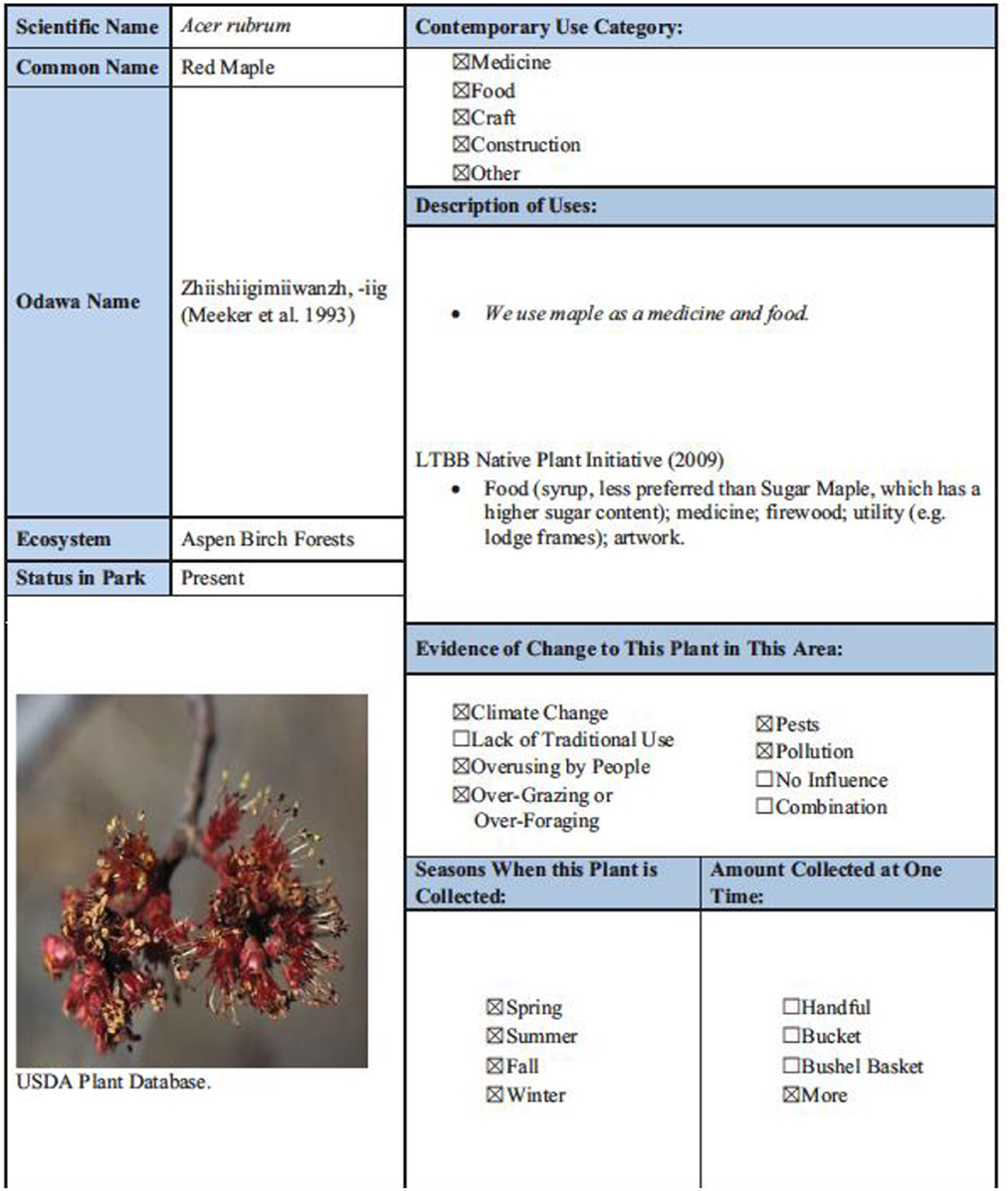
Figure 3B. Red maple entry from plant (Appendix).
These instruments recorded tribal representatives' TEK and assessments while visiting study areas. Copies of all procedures for data recordings, written questions, and tape recorders were presented to tribal representatives at their field orientation. No questions were raised as to the appropriateness of these discussion points or how the study-specific conversations would be recorded. Tribal participants were assured that they could address new discussion points during field sessions.
4. Analysis and key findings
The UofA research team transcribed tapes, analyzed data on interview forms, and filled out Excel Tables such as the one illustrated in Figure 3. A draft report of findings was submitted to all participating tribal representatives and to their cultural/environmental departments. When the findings were understood and agreed to the draft report was submitted to the Sleeping Bear Dune administration. The final report was subsequently approved, and this article contains a summary of key points from that report.
There was general agreement among the three tribes regarding TEK findings about Native observed climate change and its impacts on culturally significant plants and ecosystems. The study documented 288 traditional Odawa use plants and climate effects on five habitats located in SLBE. The categories of information about these plants and how they would be gathered and how much would be collected are needed for a Plant Gathering Agreement under the NPS Plant Gathering Rule.
Odawa perceptions of climate change were often poignant, reflecting noticeable shifts in species and distribution occurring at both small and large spatial and temporal scales. These are illustrated by changes to trees and spring greens, streams and lakes, and fish and birds. Odawa representatives focused on climate change impacts on culturally central plants like maples, changing lake and stream levels due to new weather patterns, and the rise of insects that bore and kill trees. Global warming causes extremes in weather, hot one year and cold another, record snow levels followed by little snow for years, and lake levels that fall but then rise beyond experience.
Odawa representatives expressed concerns that habitats, not just individual plant species, are experiencing the impacts of extreme climate events such as warming, cooling, drying, storms, and shifting seasonal weather. The natural vegetation of the Upper Great Lakes region is composed mostly of forests, with pine dominating in north-central and northwestern Michigan. Other habitats include marshes, bogs, swamps, and small isolated prairies (Yarnell, 1964, p. 4).
Figure 4 divides the SLBE ecology into five types of habitats that were perceived by tribal representatives to be both culturally important to Odawa people and threatened by climate change. These habitats included: (1) Upland Forest; (2) Marsh, Swale, and Wetland; (3) Mesic Sand Prairie; (4) Dune-Forest Transition Zones; and (5) Coastal Dunes and Beaches. Representatives described the habitats, their contributions to Odawa culture, and how climate change altered the habitats.
Analysis of the plant types affected by climate change are presented in Figure 5. These categories include 115 species: (1) 62 Plants/Flowers, (2) 40 Trees, (3) six Reeds, (4) four Fungi, and (5) three Ferns. Of the 288 traditional and contemporary use plants identified by Odawa representatives, 40 % were observed as being influenced by climate change.
4.1. Habitat #1: Upland forests
According to tribal representatives the habitat with the largest number of species experiencing threats due to changing climate is the upland forest, which includes a variety of hardwoods, shrubs, mosses, fungi, and flowers. The nutrient-rich soil promotes plant growth and allows trees to deeply attach their roots for stability. The majority of the upland forests have extensive stands of mature beech and sugar maple hardwoods, but also there is hemlock, white pine, basswood, white ash, red oak, ironwood, and black cherry species (Sleeping Bear Dunes National Lakeshore, 2022).
Odawa representatives identified 45 Upland Forest plant types threatened by climate change (Trosper and Parotta, 2012). Study areas at Pyramid Point, Glen Lake Sugarbush, and Platte River Point provide evidence of changes to many upland forests. Maple (Acer ssp.), birch (Betula ssp.), and ash (Fraxinus ssp.) were identified as experiencing signs of decline, poor health, and other disruptions in seasonal availability related to climate change.
Maple trees are culturally central to Odawa people, who used the sap in the spring for food and medicine. Maple wood is used for crafts and construction. The inner bark is used for medicine and cough syrup.
The process of harvesting maple sap, also known as sugaring, requires freezing temperatures at night with warming temperatures during the day. If the average temperatures warm six to ten degrees in winter, negative impacts are possible (Kling et al., 2003). The cultural specification of March as the sugaring month may no longer be true. The Little Traverse Bay Bands produced a book called Native Plant Initiative which observes that the Anishnaabemowin name for maple syrup is ziinsiibaakwad and the month of March is known as the Maple Syrup Gathering Moon, or Ziisiibaakade Giizis (Pilette, 2009, p. 24). Odawa cultural traditions now may be forced to shift when they hold sugaring camps because alternate cooling and warming events are needed to get sap flowing. The camps now have to occur in February or April as opposed to March. Shifting the time of sugaring is culturally important because it is a key point in the traditional ceremonial cycle.
Wiigwaas, or paper birch, plays a vital role in Odawa culture as well as maple. Birch bark serves in the production of crafts, construction, canoes, and other uses (Figure 6). Much like maple sap, a birch tree can be tapped for sap, which is used for candies, syrup, and sugar (Great Lakes Indian Fish and Wildlife Commission, 2018). Birch trees serve as a complimentary plant for maple sugaring, with storage containers and baskets made from birch bark14 used to store sugar, sap, and syrup. Droughts related to climate change pose a serious threat to both maple and birch trees and therefor associated ceremonies (Kling et al., 2003). In-line winds during thunderstorms blow down large sections of trees.
4.1.1. Odawa comments
• They used to sugar at the end of February, March. I think this year they didn't do it until April, but we had a harder winter, a longer winter, and we had the longest snow, and even our Great Lakes froze over for the first time in a long time. We're talking about the big waters, not the little lakes around here. So, it got frigid here. That has had an impact on some of the plants and the trees, so with a longer colder winter we weren't able to start doing maple sugar until April, in fact I think it just got done and we're in mid-May now. So I do think, yeah, obviously the climate does have an impact on our medicines and our trees.
• It's not like it was in the old days, I think the nights and days aren't as cold as they used to be. That's what brings that sap up into the trees. It draws it and pushes that sap up. I used to hear those trees snap up there in the woods because, those maple trees, that sap would freeze and crack the trees. I used to have to wait for the bus and hear the trees out there. It used to be cold. I remember days when you go outside and breathe and your breath would freeze.
• If we had maintained the low temperatures that we were having this year for a longer duration, it would really have knocked out the Emerald Ash Borer that would have been great. Since we don't maintain or can't maintain those cold temperatures for long periods anymore though they [Emerald Ash Borer] are able to hang on. The Emerald Ash Borer showed up in the early 1990's but we didn't know the extent of the damage until 1997 or 1998. Now it's too late, they devastated the black ash stands across the state. In response to the devastation of the black ash we've started collecting seeds and put them in a seed bank. Maybe we can restart once this pest passes.
Ceremonies of all kinds especially those associated with medicine require certain kinds of containers, tools for stirring, and mats for placement so the ceremonies will be successful. As climate change impacts these plants it reduces or eliminates the performance of traditional curing ceremonies.
4.2. Habitat #2: Marshes and wetlands
Wetlands and Marshes have nutrient-rich soils that are generally saturated and thus support an abundant growth of reeds, shrubs, flowers, and aquatic plants. Many of the plants identified by Odawa representatives grow in slow-moving or still waters, that are characteristic of swamps, swales, and wetland areas (Figure 7).
Wild rice (Zizania ssp) is a key wetland resource. Although not now available within SLBE, it is being considered for reintroduction. A wetland habitat is a requirement for wild rice to grow, but recently the temperatures and availability of water have impacted where it can grow in the region. Warming winters and changes in water level are reducing the habitat of wild rice.
Wild rice is a pillar of cultural health for the Anishinaabeg people, and any decline in wild rice quality or availability negatively affects their wellbeing.
Traditional Ojibway (Odawa) life elevates rice above being for consumption or barter. Stories and legends reinforced the ceremonial uses of manoomin. Taboos and proscriptions against eating it at certain times show the centrality of wild rice in Ojibway culture (Vennum, 1988, p. 58).
The act of harvesting plants “encompasses the holistic aspects of wellness and includes physical, emotional, psychological, and spiritual realms of the individual and community” (Lynn et al., 2013, p. 548). Manoomin is this type of sacred resource. Even sharing the legends associated with the plant are reserved for powerful people and they only do so during special times of year (Vennum, 1988, p. 59).
Climate change threats to wild rice can harm transmission of cultural knowledge and learning of values. Warmer temperatures can cause damage by reducing water levels, reducing seed dormancy, favoring invasive and outcompeting plants, and creating an environment more conducive to brown spot disease (Cozzetto et al., 2013, p. 71).
4.2.1. Odawa comments
• There's this patch where we used to get that Sweet Flag. So, my sister and I tried to gather that last August, which is about the time when you want to collect it, August, late July, but it was all dried up, that spot where we always got the Sweet Flag. It reminds me because the ground was kind of like this [at Platte River Point], it was wet and moist, but that ground was just, it reminded me of desert sand because it was all dried up, it was really thriving back in 1998.
• I've watched the lake level here at Lake Michigan drop. Maybe now there are spots where water used to meet, say, within 5 or 6 feet of the road, M-22, and up until this year you could see for 200 yards a dry, stony shoreline before you get to the water. I have noticed a lot hotter summers up until right now too. I remember last year being in the 80s, mid 80s right now, about the end of May. I mean, that's the kind of the stuff that really comes to the forefront for me, immediately recognizable as the winters and the summers are changing.
• I would say it's dryer there than it used to be, that's what I think. Last winter and this summer have been very different than the last 15 years. The temperatures have changed, it's jumping all over, unpredictable. That has to have an effect on the plants that grow here, plus the acid rains that bombard them.
• Climate change is drying up the wetlands. These plants really need a high amount of moisture and water, like mesquiguish and wiikehn.
4.3. Habitat #3: Mesic sand prairies
Mesic Sand Prairies have rich and moist soils, and are host to a diversity of wildflowers, grasses, and low growing shrubs like blueberry bushes. Odawa representatives identified 19 plants in grass meadow habitats that they observed being impacted by climate change including several types of berry bushes, mushrooms, and many medicinal flowers. Drought, cooling temperatures, and prolonged periods of freezing temperatures were described as some of the main climate related changes affecting the mesic sand prairie areas.
The park has clearings that are open mesic sand prairies, many of which were caused by agricultural and logging in the early 20th century. Traditionally, however, such habitats were created by selective Odawa burning. Many of the plants, like the berries, require burning to thrive (Stoffle et al., 1998; Trusler and Johnson, 2008).
4.3.1. Odawa comments
• We've been having dryer spring seasons, because we haven't had that snow packed up until this past winter [2013–2014]. And… you need kind of that moist, wet spring to get a good bounty of the morel mushroom, because if it's really dry you're just not going to get it like you had before.
• Wow, that is a spring morel [mushroom]! Finding it here in September is insane!
• Plants used to come up fuller and healthier in nice open areas like this [walking up to Pyramid Point]. We only see that if it rains hard. There is less water overall. The plants as a whole are not growing as well as they used to.
4.4. Habitat #4: Dune-forest transition habitat
The Dune-Forest Transition Zones (Figure 8) contains seven plants, identified by Odawa representatives as threatened by climate change. This habitat is defined as an open dune area that is typically nestled within a forested landscape, with the dune sands supporting a variety of forest types (Michigan State University Extension, 2014). Exposed dunes are dominated by grasses and shrubs located on wind-deposited sand formations near the Lake Michigan shoreline. Dune formation and the distribution of plants are strongly affected by lake-driven winds. As the dunes stabilize farther from the foredune, forests begin to develop. Typically, pines, including Jack pine (Pinus banksiana), white pine (Pinus strobus), and red pine (Pinus resinosa), are among the first to establish (Albert, 1999, p. 3). Areas studied included Pyramid Point and near Platte River Point.
4.4.1. Odawa comments
• A lot of trees are coming down because of wind, look at these [trees] up here on the bluff, falling over now with roots hanging out. We actually had droughts. For the last couple of the years for the summer we don't have any rain, so we've seen less precipitation. Less water is bad for tree roots, they aren't holding on well, so they just blow over.
• My mom said it's gotten a lot windier in the past 10 years. More severe wind, especially along the lakeshore.
• Summers have changed a bit, [they are] slow to come. It's pretty obvious that there are climate changes happening. It influences a lot relating to plants, like where and when you can find them, and also what types of plants start crowding and taking over where Native plants were previously. If it warms up we have new plants that move up here, you know, stuff that didn't used to grow here.
4.5. Habitat #5: Coastal dune and beaches
According to one Odawa elder, in SLBE there are spiritual places used for healing ceremonies, vision questing that culturally center the Odawa people (Figure 9). Plants growing on the dunes have special strengths and uses. The name of the Sleeping Dune park reflects the ancient oral heritage stories of bears and the dunes.
Coastal dunes and beaches have a soil that is low in nutrients and made up of granular silica. Sand from these dunes and beaches blows easily and changes the contour of the land. These habitats experience the direct impacts of inclement weather more than other habitats because there are no large trees to provide a canopy shelter. The plants that grow in the dune-beach habitat have deep roots, thus they are better able to endure the harsh environmental conditions.
Dune systems are well suited for the study of succession and ecological change because they change rapidly. When Lake Michigan levels are lower, the beaches and dunes are exposed making new sand spits, sand bars, and foredunes; areas that are rapidly colonized by beach grass.
Points where streams flow into Lake Michigan often experience sand build up due to blowing sands that choke off or deflect the stream flow. This is exemplified at the Otter Creek Mouth where it occurs during different times of the year (Figure 10). Storms and high lake levels can cause even more rapid changes in plant communities (Michigan State University Extension, 2014). Within one or two human generations the vegetation can change from beach grass to shrubs and trees. Fish spawning is directly impacted by modifications to stream flows.
Culturally significant medicinal plants grow in the beach area at Otter Creek Mouth and Good Harbor Beach. Here beach pea, honeysuckle, bearberry, and pitcher's thistle are all threatened by climate changes including rainfall and lake levels, winds and storms, and seasonal temperatures.
4.5.1. Odawa comments
• A lot of the plants we need grow on these dune areas, around here [Otter Creek Mouth]. It's getting harder and harder to find them [plants], and some plants we can only pick right when we need them, you can't pick them ahead of time and if they aren't there right when we need them, then that's really a crisis.
• The plant that comes to mind as really limited and hard to find anymore is Pitcher's Thistle [Cirisium pitcheri], if you're going to find it, then it should be around here, this type of dune area [Otter Creek Mouth].
• We had some brutal storms this summer, things I've never seen before and the older people had never seen before in their lifetime. I live in Harbor Springs, MI and we had a giant wave come off Lake Michigan, nothing like this has ever happened before. It was huge, and powerful, it wiped out the city dock and overturned the big boats, like fishing boats, and people's big yachts, just flipped them over. It left debris, and dirt, and all sorts of sandy kinds of stuff around the harbor. I don't know what's causing that strange type of event out on the water, but it has to have something to do with big winds.
5. Discussion
The SLBE studies of Odawa people and their knowledge of climate change achieved all the stated study goals. The first was to determine what kinds of climate change data are available by talking with contemporary Odawa tribal representatives. Among the 288 identified traditional use plants in the park, 115 were known to have been influenced by climate change. All five habitats studied were known in specific ways to have been influenced by climate change. Knowledge of climate change is widely recognized by tribal members as a part of contemporary Odawa TEK.
A second goal was to document TEK of plants, ecosystems, and patterns of contemporary use. An ethnobotanical data collection instrument was developed and used to record observations about traditional and contemporary use plants that were identified in person during field visits to the park. This form and way of gathering data was seen as a model for collecting ethnobotanical data and was so referenced in the NPS guidelines for establishing a Plant Gathering Agreement between a tribe and a park (36 CFR Part 2, Code of Federal Regulations, title 32, Sec. 2.6. 2016).
These studies also documented Odawa cultural persistence in the face of extreme suppression and exclusion. While these studies have only identified a portion of the contemporary knowledge of the Odawa people who are members of these three tribes, clearly the plant and habitat knowledge shared by tribal representatives is impressive. To tie it closely from place to place and from plant to plant to the process of climate change in many of its dimensions is a special observation. At a more abstract level, these findings suggest the further question of how the Odawa retained TEK during the long and painful transition from being the aboriginal occupants of traditional homelands to being contemporary tribal members on small reservations. Today the people of these three reservations reach out to federal and state land and water managers to find a renewed role in the co-management of aboriginal resources.
These SLBE studies document that Odawa people have extensive knowledge of their traditional lands and resources and that they are committed to working with the NPS to preserve these for future generations. The process of knowledge transfer from a traditional people to a federal agency, however, requires certain understandings. The first of these is to understand how TEK is acquired, refined, and maintained through various cultural practices. The second is how to take ancient knowledge and apply it to future management decisions.
5.1. Traditional science embedded in culture
The Odawa bring an estimated 600 years of in-place learning and adaption to shifting weather and climate conditions to the preservation challenge posed by climate change. Their TEK understandings are extensive, as is indicated by detailed knowledge of (1) 288 plants, (2) the spawning of various fish species, (3) the biology and physical ecology of five diverse habitats, and (4) the seasonal movements of water, sand, and wind.
Berkes et al. (2000) and Berkes (2018) document that TEK often represents observations acquired over thousands of years due to direct contact with the environment. Day-to-day this ancient knowledge base grows as new observations are made and then added. It is not until a people have worked with and learned from their environment for five generations (about 125 years) that “they have a firm information base about the environment and how to use the land without hurting it” (Stoffle et al., 2003, p. 104). TEK thus includes in-depth understandings of specific biological entities (plants, mammals, birds, insects, fish) and how these are related to physical entities (rocks, bodies of water), landforms (mountains, isolated hills, unusual rock formations), and meteorological phenomena (Pierotti, 2011, p. 9).
Developing TEK generally requires generations of learning from and co-adapting with environmental events in the same ecosystem (Stoffle et al., 2003, p. 106). The Odawa people have lived hundreds of years in the Sleeping Bear Dunes area. With knowledge comes a commitment to the science methods that previous generations used to learn and adapt; suggesting “if you follow “our ways” you will always have food, shelter, and health, and the environment will be in balance” (Stoffle et al., 2003, p. 106).
The Odawa have learned to be resilient to past climate changes; however, there are new threats. If a culturally central plant species has not grown abundantly enough to harvest, aspects of traditional life cannot be taught to younger generations and the species is not available for use and ceremony (Lynn et al., 2013, p. 548). If a certain tree is not available for making a medicine basket, then the curing ceremony cannot be accomplished even if the medicine is available. Because knowledge involves both sacred and secular interpretations of nature, climate change potentially can have a negative effect on the performance and intergenerational transference of Odawa religion.
Climate changes also affect tribal sovereignty including treaty rights, federal policies, and federal trust responsibilities that support tribal access to cultural resources (Vogesser et al., 2013, p. 622). Changes to the access and availability of natural resources can cause the “erosion of traditional practices and knowledge” (Lynn et al., 2013, p. 548). The new NPS Plant Gathering Rule is designed in part to mitigate this problem (36 CFR Part 2, Code of Federal Regulations, title 32, Sec. 2.6. 2016).
5.2. Science partnerships in climate resilience
Odawa concerns expressed in these studies illustrate the small and large-scale impacts of changing climate. Odawa people with plant and animal knowledge have observed increasing trends in climate change over at least the last six hundred years. Activities like maple sugaring no longer occur at the culturally prescribed time. With almost 300 contemporary use plants and many habitats being threated, Odawa people are concerned for their future and wish to engage with SLBE managers to assure that these natural resources will be there to support the cultural continuity of new generations.
There are various epistemological divides between native science and western science (Agrawal, 2009; Stoffle et al., 2020); a notion used here to explain why heritage environmental communication skills are essential for participants to understand and believe each other (Stoffle et al., 2016; Sjolander-Lindqvist et al., 2022). How data are acquired and interpreted by people with Native science is important in communication. Ancient and contemporary Odawa knowledge derives from natural observations, and these often are expressed as spiritual understandings. If traditional people are to help apply the lessons from their past, their knowledge must be respected and trusted by contemporary park managers and scientists. This does not imply that one science should in any way replace the other but instead doubts should be suspended, and efforts made to translate understandings into each other's paradigms.
The findings of the two studies used in this analysis complement decades of research on the subject by scholars around the world. In a 2008 panel on the topic sponsored by the American Museum of Natural History 57 indigenous narratives were recorded describing climate change and its impacts on indigenous peoples and their environments (Alexander et al., 2011, p. 479). Still there sometimes is a reluctance by land managers to accept indigenous science observations until confirmed by western science (Brook and McLachlan, 2005). An analysis of journal articles and reports using native knowledge, sometimes called Local Ecological Knowledge (LEK), concluded that there is an increasing number of ecologists and conservation biologists actively employing LEK and working collaboratively with communities, which helps accumulate a critical mass of evidence for and support of the value of local knowledge (Brook and McLachlan, 2008).
Munshi et al. (2020, p. 573) argue that top-down western science must be balanced with understanding of how local people understand climate change; thus, there is a need to engage with the culture of the everyday lived experiences of people. Clearly studies such as these funded by and co-produced by the NPS lay a foundation for mutual respect and co-management.
While beyond the scope of this essay, it is important to note some of what happens when the park and tribes began to talk about using TEK for climate mitigation. In one brainstorming meeting the issue was discussed regarding how TEK could inform park decisions about the culturally and ecologically key Black Ash Tree species that has largely died and will eventually totally die due to the emerald Ash Borer. All these trees are expected by the tribes and the park to die in the region, with only some continuing to live far to the north in Canada, certainly beyond the reach and use of either the park or the tribes. Given its critical role in Odawa ceremony and medicine, a suggestion was made to cut down the remain healthy trees in the park and place them in shallow lakes for future use by the tribes. Thus, the water-preserved wood would be available over time to Odawa people, the borers would die out in the park, and a long-term management solution would occur. Normally such a radical action would not be considered by the park, but it was considered when it was mutually discussed as potentially acceptable by them and the tribes. Another possible mitigation would be to re/establish strategic burning of blueberry and other patches to reduce fuel loads and stimulate culturally valued plants. Tribes suggested traditional cultural burns. The tribes would like to plant wild rice in the shallow park lakes and then have the right to traditionally manage and harvest the rice under the new Gathering Rule. Clearly there are common ecological management issues between the park and the tribes.
Data availability statement
The raw data supporting the conclusions of this article will be made available by the authors, without undue reservation.
Ethics statement
Ethics review and approval/written informed consent was not required as per local legislation and institutional requirements.
Author contributions
The authors of this study are equally responsible for the findings. RS was Principal Investigator of the study and thus responsible for the conduct of the research. ME was the point of contact for the regional National Park Service, initially designed the study, and one of the authors of the Plant Gathering Rule. CS was the senior student who worked to accomplish field tasks and direct data analysis in the study laboratory at UofA. DB was a primary point of contact with the three Odawa tribes and recognized cultural advisor. KV made essential contributions to the study and was a full co-author of this manuscript. All authors contributed to the article and approved the submitted version.
Funding
Funds for this study were provided by the National Park Service, Midwest Region under agreement number P13AC00710/UAZDS-403 to the Board of Regents, The University of Arizona, Tucson, Arizona.
Acknowledgments
Miigwech! Thanks to all who helped conduct the study. Some of these people are listed below.
Grand Traverse Bay (GTB): Alvin Pedwaydon, Chairman GTB Robert Kewaygoshkum, Vice Chairman, and Cindy Winslow, Museum Director.
Little Traverse Bay: Fred Kiogima, Chairman, Eric Hemmenway, Tribal Historic Preservation officer, and Anthony Davis, Cultural Resource Office.
Little River Band (LRB): Larry Romanelli, Ogema, Chairman, Jonnie Sam, II Historic Preservation Director, Jimmie Mitchell, Natural Resources, and Valerie Chandler, Environmental.
Participating Elders: Hank Bailey, Carrie Leaureau, Desmond Berry, Tom Callison, Brett Fessell, Eric Hemmenway, Peggy Holappa, Arlene, Jim Naganashe, Jessica Domini, and Jimmie Mitchel.
National Park Service, Sleeping Bear Dunes (SLBE): Dusty, Schultz, Superintendent, Tom Ulrich, Deputy Superintendent, Laura Quackenbush, Museum Technician, Amanda Brushaber, Biologist, Natural Resources, and Kevin Skerl.
University of Arizona, School of Anthropology (SofA): Diane Austin, Chair, Julietta Gomez, and Veronica Peralta, with students Kathleen Van Vlack, Katherine Brooks, Evelyn Pickering and Chris Sittler.
Conflict of interest
The authors declare that the research was conducted in the absence of any commercial or financial relationships that could be construed as a potential conflict of interest.
Publisher's note
All claims expressed in this article are solely those of the authors and do not necessarily represent those of their affiliated organizations, or those of the publisher, the editors and the reviewers. Any product that may be evaluated in this article, or claim that may be made by its manufacturer, is not guaranteed or endorsed by the publisher.
Supplementary material
The Supplementary Material for this article can be found online at: https://www.frontiersin.org/articles/10.3389/fclim.2023.979721/full#supplementary-material
References
Agrawal, A. (2009). Dismantling the divide between indigenous and science knowledge. Develop. Change 26, 413–439. doi: 10.1111/j.1467-7660.1995.tb00560.x
Albert, D. A. (1999). Natural Community Abstract for Open Dunes. Michigan Natural Features Inventory. Lansing, MI. Available online at: http://mnfi.anr.msu.edu/abstracts/ecology/open_dunes.pdf (accessed September 2019).
Alexander, C., Bynum, N., Johnson, E., King, U., Mustonen, T., Neofetis, P., et al. (2011). Linking indigenous and scientific knowledge of climate change. Bioscience 61, 477–484. doi: 10.1525/bio.2011.61.6.10
Berkes, F. (2018). Sacred Ecology: Fourth Edition. New York, NY: Routledge. doi: 10.4324/9781315114644
Berkes, F., Colding, J., and Folke, C. (2000). Rediscovery of traditional ecological knowledge as adaptive management. Ecol. Appl. 10, 1251–1262. doi: 10.1890/1051-0761(2000)010(1251:ROTEKA)2.0.CO;2
Brook, R., and McLachlan, S. (2005). On using expert-based science to “test” local ecological knowledge. Ecol. Soc. 10, r3. doi: 10.5751/ES-01478-1002r03
Brook, R., and McLachlan, S. (2008). Trends and prospects for local knowledge in ecological and conservation research and monitoring. Biodivers. Conserv. 17, 3501–3512. doi: 10.1007/s10531-008-9445-x
Cleland, C. (1992). Rites of Conquest: The History and Culture of Michigan's Native Americans. Ann Arbor, MI: University of Michigan Press. doi: 10.3998/mpub.9272
Clifton, J., Cornell, G., and McClurken, J. (1986). People of the Three Fires: The Ottawa, Potawatomi, and Ojibway of Michigan. Michigan Indian Press, Grand Rapid Inter-Tribal Council. Grand Rapids, MI: West Michigan Printing.
Cozzetto, K., Chief, K., Dittmer, K., Brubaker, M., Gough, R., Souza, K., et al. (2013). Climate change impacts on the water resources of American Indians and Alaska Natives in the U.S. Climate Change 120, 569–584. doi: 10.1007/s10584-013-0852-y
Fox, D. (2007). Back to the no-analog future? Science. 316, 823–826. doi: 10.1126/science.316.5826.823
Gatewood, J. B. (2000). Distributional instability and the units of culture. Ethnology 39, 293–303. doi: 10.2307/3774048
Glassberg, D. (2014). Place, memory, and climate change. Public Hist. 36, 17–30. doi: 10.1525/tph.2014.36.3.17
Grand Travere Bay Band of Odawa Chippewa Indians. (2020). Available online at: https://www.gtbindians.org/
Great Lakes Indian Fish Wildlife Commission. (2018). Climate Change Could be Changing the Face of Indian Country and the World. Available online at: https://www.indiancountrynews.com/index.php/news/wildlife/14641-great-lakes-indian-fish-and-wildlife-commission-has-team-working-on-studies-climate-change-could-be-changing-the-face-of-indian-country-and-the-world (accessed September 2019).
Halmo, D., Stoffle, R., and Evans, M. (1993). Paitu nanasuagaindu pahonupi (Three Sacred Valleys): cultural significance of gosiute, paiute, and ute plants. Hum. Organ. 52, 142–150. doi: 10.17730/humo.52.2.k05p2r2164186196
Hølleland, H., Skrede, J., and Holmgaard, S. (2017). Cultural heritage and ecosystem services: a literature review. Conserv. Manage. Archaeol. Sites 19.3, 210–237. doi: 10.1080/13505033.2017.1342069
Howitt, R. (2020). Decolonizing people, place and country: nurturing resilience across time and space. Sustainability 12, 5882. doi: 10.3390/su12155882
Joosse, S., Powell, S., Bergeå, H., Böhm, S., Calderón, C., Caselunghe, E., et al. (2020). Critical, Engaged and change-oriented scholarship in environmental communication: six methodological dilemmas to think with. Environ. Commun. 14, 1–14. doi: 10.1080/17524032.2020.1725588
Karamanski, T. (2012). Blackbird's Song: Andrew J. Blackbird and the Odawa People. East Lansing, MI: Michigan State University Press.
Kling, G., Hayhoe, K., Johnson, L., Magnuson, J., Polasky, S., Robinson, S., et al. (2003). Confronting Climate Change in the Great Lakes Region: Impact on Our Communities and Ecosystems. Washington, D.C.: Union of Concerned Scientists, Cambridge, Massachusetts, and Ecological Society of America.
Little Traverse Bay Band of Odawa Indians. (2020). Available online at: https://ltbbodawa-nsn.gov/
López-Maldonado, Y. (2014). “Towards an understanding of the human-environment system of mayan communities,” in Workshop on the Ostrom Workshop 5 (Bloomington, IN: Indiana University). doi: 10.13140/RG.2.1.4681.2240
Lynn, K., Daigle, J., Hoffman, J., Lake, F., Michelle, N., Ranco, D., et al. (2013). The impact of climate change on tribal traditional foods. Climatic Change 120, 545–56. doi: 10.1007/s10584-013-0736-1
Malcomson, F. C., Willis, N. D., McCallum, I., Xie, L., Shivappa, N., Wirth, M. D., et al. (2014). Climate Change and Indigenous Peoples in the United States: Impacts, Experiences, and Actions. New York: Springer.
McClurken, J. (2009). Our People, Our Journey: The Little River Band of Ottawa Indians. East Lansing, MI: Michigan State University.
Michigan State University Extension. (2014). Michigan's Natural Communities. Available online at: http://mnfi.anr.msu.edu/communities/index.cfm (accessed September 2019).
Munshi, D., Kurian, P., Cretney, R., Morrison, S., and Kathlene, L. (2020). Centering culture in public engagement on climate change. Environ. Commun. 14, 573–581. doi: 10.1080/17524032.2020.1746680
National Park Service. (2023). Fulfilling the national park service trust responsibility to Indian tribes, alaska natives, and native hawaiians in the stewardship of federal lands and waters. Policy Memorandum 22–03. Washington DC: Department of the Interior.
Paerregaard, K. (2020). Communicating the inevitable: climate awareness, climate discord, and climate research in peru's highland communities. Environ. Commun. 14, 112–125. doi: 10.1080/17524032.2019.1626754
Patty, L. (2001). Indian Nations of Wisconsin: Histories of Endurance and Renewal. Madison, WI: Wisconsin Historical Society.
Pierotti, R. (2011). Indigenous Knowledge, Ecology and Evolutionary Biology. New York, New York: Routledge. doi: 10.4324/9780203847114
Pilette, J. (2009). Little Traverse Bay Bands of Odawa Indians Native Plants Initiative. Little Traverse Bay Bands of Odawa Indians Environmental Services Department for Conservation Resource Alliance.
Sjolander-Lindqvist, A., Murin, I., and Dove, M. (2022). Anthropological Perspectives on Environmental Communication. Switzerland, AG: Palgrave Studies in Anthropology of Sustainability. doi: 10.1007/978-3-030-78040-1
Sleeping Bear Dunes National Lakeshore (2022). Natural Resources Research. Available online at: https://www.nps.gov/slbe/learn/nature/nrresearch.htm (accessed June 2022).
Stoffle, R., Arnold, R., and Bulletts, A. (2016). “Talking with nature: southern paiute epistemology and the double hermeneutic with a living planet,” in Collaborative Heritage Management, eds Tully, G., and Rodges, M. (New Jersey: Gorgias Press), p. 75–99. doi: 10.31826/9781463236892-005
Stoffle, R., Arnold, R., and Van Vlack, K. (2015a). Facing the unimaginable: hopi and southern paiute respond to massive risk events. Appl. Anthropol. 35, 13–22.
Stoffle, R., Brooks, K., Pickering, E., Sittler, C., and Van Vlack, K. (2015b). Climate Change Impacts on Odawa Contemporary Use Plants and Culture at Sleeping Bear Dunes National Lake Shore. Tucson, AZ: University of Arizona.
Stoffle, R., Evans, M. J., and Carroll, C. (2023). Returning to Gather: Cherokee and National Park Service Make a Plant Gathering Agreement at Buffalo National River, Arkansas. Chapter in a Book Proposal entitled National Parks and Native People. University of Oklahoma Press, Public Lands History Series.
Stoffle, R., Halmo, D., and Evans, M. (1999). Puchuxwavaat Uapi (To Know About Plants): traditional knowledge and the cultural significance of southern paiute plants. Hum. Organ. 58, 416–429. doi: 10.17730/humo.58.4.p2w2tp1138551180
Stoffle, R., Halmo, D., Evans, M., and Olmsted, J. (1990). Calculating the cultural significance of american indian plants: paiute and shoshone ethnobotany at Yucca Mountain, Nevada. Am. Anthropol. 92, 416–432. doi: 10.1525/aa.1990.92.2.02a00100
Stoffle, R., Sittler, C., Van Vlack, K., Pickering, E., and Lim, H. (2020). Living universe or geofacts: stone arches in utah national parks: epistemological divides in heritage environmental communication. Int. J. Intangible Heritage 15, 16–27.
Stoffle, R., Toupal, R., and Zedeno, N. (2003). “Landscape, nature, and culture: a diachronic model of human-nature adaptations,” in Nature Across Cultures: Views of Nature and the Environment in Non-Western Cultures, eds H. Selin (Great Britain: Kluwer Academic Publishers), p. 97–114. doi: 10.1007/978-94-017-0149-5_5
Stoffle, R., Zedeno, M., Hefley, G., and Pittaluga, F. (2001). Ojibway Natural Resource Use In the Western Great Lakes. Tucson, AZ: University of Arizona.
Stoffle, R., Zedeno, N., Pittaluga, F., and Dewey-Hefley, G. (1998). Traditional Ojibway Resources in The Western Great Lakes. Report prepared for National Park Service. Tucson, AZ: Bureau of Applied Research in Anthropology, The University of Arizona.
Stoffle, R. W., Halmo, D., and Austin, D. (1997). Cultural landscapes and traditional cultural properties: a southern paiute view of the grand canyon and colorado river. Am. Indian Q. 21, 229–250. doi: 10.2307/1185646
Trosper, R., and Parotta, J. (2012). “Introduction: the growing importance of traditional forest-related knowledge,” in Traditional Forest-Related Knowledge, eds Parrotta, J., and Trosper, R. (Dordrecht: Springer), p. 1–36. doi: 10.1007/978-94-007-2144-9_1
Trusler, S., and Johnson, L. (2008). “Berry patch” as a kind of place—the ethnoecology of black huckleberry in northwestern Canada. Hum. Ecol. 36, 553–568. doi: 10.1007/s10745-008-9176-3
Turner, N. (2016). “We give them seaweed”: social economic exchange and resilience in Northwestern North America. Indian J. Tradition. Knowl. 15, 5–15.
UNESCO (2007). UNESCO, World Heritage Convention Glossary- Cultural Landscapes. Available online at: https://whc.unesco.org/en/glossary/.
UNESCO (2020). World Heritage and Biodiversity. Available online at: https://whc.unesco.org/en/biodiversity.
Vennum, T. (1988). Wild Rice and the Ojibway People. St. Paul, MN: Minnesota Historical Society Press.
Vinyeta, K., and Lynn, K. (2013). Exploring the role of traditional ecological knowledge in climate change initiatives. Gen. Tech. Rep. PNW-GTR-879. Portland, OR: US Department of Agriculture, Forest Service, Pacific Northwest Research Station. doi: 10.2737/PNW-GTR-879
Vogesser, G., Lynn, K., Daigle, J., Lake, F., and Ranco, D. (2013). Cultural impacts to tribes from climate change influences on forests. Clim. Change 120, 615–626. doi: 10.1007/s10584-013-0733-4
Wegner, T. (2011). Indian dances and the politics of religious freedom, 1870–1930. J. Am. Acad. Religion 79, 850–878. doi: 10.1093/jaarel/lfr061
Wheeler, H., Danielsen, F., Fidel, M., Hausner, V., Horstkotte, T., Johnson, N., et al. (2020). The need for transformative changes in the use of Indigenous knowledge along with science for environmental decision making in the Arctic. People Nat. 2, 544–556. doi: 10.1002/pan3.10131
Whittaker, R. (1998). Island Biogeography: Ecology, Evolution, and Conservation. Oxford: Oxford University Press.
Wildcat, D. (2013). Introduction: climate change and indigenous peoples of the USA. Clim. Change 120, 509–515. doi: 10.1007/s10584-013-0849-6
Keywords: traditional ecological knowledge, climate change, Odawa Indians, native Americans, National Parks, Michigan, (Min.5-Max.8)
Citation: Stoffle RW, Evans MJ, Sittler C, Berry DL and Van Vlack KA (2023) Native knowledge of great lakes ecology: Climate changes to Odawa lands. Front. Clim. 5:979721. doi: 10.3389/fclim.2023.979721
Received: 27 June 2022; Accepted: 08 March 2023;
Published: 27 March 2023.
Edited by:
Chad B. Wilsey, National Audubon Society, United StatesReviewed by:
Shah Md Atiqul Haq, Shahjalal University of Science and Technology, BangladeshOlga Laiza Kupika, Chinhoyi University of Technology, Zimbabwe
Copyright © 2023 Stoffle, Evans, Sittler, Berry and Van Vlack. This is an open-access article distributed under the terms of the Creative Commons Attribution License (CC BY). The use, distribution or reproduction in other forums is permitted, provided the original author(s) and the copyright owner(s) are credited and that the original publication in this journal is cited, in accordance with accepted academic practice. No use, distribution or reproduction is permitted which does not comply with these terms.
*Correspondence: Richard W. Stoffle, cnN0b2ZmbGVAYXJpem9uYS5lZHU=; Michael J. Evans, bWljaGFlbF9ldmFuc0BucHMuZ292
 Richard W. Stoffle
Richard W. Stoffle Michael J. Evans
Michael J. Evans Christopher Sittler
Christopher Sittler Desmond L. Berry3
Desmond L. Berry3 Kathleen A. Van Vlack
Kathleen A. Van Vlack